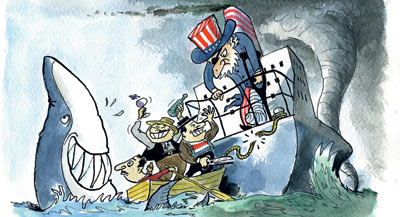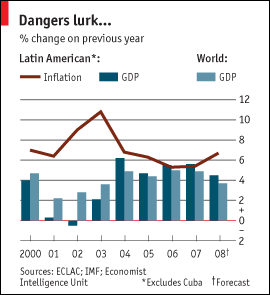Latin America's economies
A coming test of virtue
April 10, 2008 - economist.com From The Economist print edition
Once a byword for financial busts, Latin America has so far escaped this credit crunch unscathed. But for how much longer?

Illustration by Claudio Munoz
MIAMI-- WHEN Latin Americans get together with bankers on American soil it has usually been to seek succour for their sickly economies. Yet at the annual meeting of the Inter-American Development Bank (IDB) in Miami this week, the relative health of the participants was reversed. Thousands of empty flats in gleaming new skyscrapers clustering around Miami's downtown hotels bear witness to the severity of the housing-market bust in South Florida. Distracted by their own losses, the investment bankers were in subdued mood or stayed away. The Latin Americans, for their part, were preening themselves over the vigour of their own economies. They hope they have "decoupled" from their giant neighbour to the north.
Are such hopes justified? Latin America is doing better than at any time since the 1960s. Economic growth has averaged over 5% a year since 2004, inflation has been generally low, direct investment is arriving in record quantities, and the region's current account and fiscal accounts are both in surplus. Of course the average conceals wide (and widening) variations. But to the surprise of some, the credit crunch has so far had little discernible effect. Indeed, as world prices for many of Latin America's key commodity exports continue to rise, the pace of growth has even accelerated in some countries.
Interest-rate cuts in the United States have prompted a number of investors there to buy higher-yielding Latin American shares and bonds. Most Latin American stockmarkets have been holding up relatively well. The region's sovereign bonds are no longer tracking junk bonds up north; spreads (ie, the premium over the yield on American Treasury bonds) have risen barely more than one-and-a-half percentage points since last July, while those on American junk bonds have risen five times as much. This month Fitch, a credit-rating agency, raised Peru's bonds to investment grade.
But strains and anxieties are starting to emerge. Higher world prices for energy and food mean that inflation is edging up. That is testing the policy regime (of inflation targets and flexible exchange rates) that has underpinned the achievement of price stability in many countries over the past decade. Several central banks, including those of Chile and Colombia, have missed their inflation targets. Some have begun to tighten interest rates. Brazil's Central Bank is widely expected to raise rates on April 16th, ending three years of monetary easing. But this may cause currencies to strengthen further, causing difficulties for exporters just when the current-account surplus is narrowing; Brazil is expected to post a current-account deficit of perhaps 1% of GDP this year, for example.
 Meanwhile, the troubles in the outside world are raising doubts about growth. So far the best guess is that a mild recession in the United States and a slowing world economy will cut growth in Latin America this year by one point, to 4.5%. Commodity-exporting South America should be relatively unscathed. Even in Mexico, where four-fifths of exports go to the United States, the economy has remained surprisingly robust. But Mexico's economy still moves in tandem with industrial production north of the border, and this may have further to fall. Production is currently flat; in 2001, when both countries were last in recession, it fell by 5%.
Meanwhile, the troubles in the outside world are raising doubts about growth. So far the best guess is that a mild recession in the United States and a slowing world economy will cut growth in Latin America this year by one point, to 4.5%. Commodity-exporting South America should be relatively unscathed. Even in Mexico, where four-fifths of exports go to the United States, the economy has remained surprisingly robust. But Mexico's economy still moves in tandem with industrial production north of the border, and this may have further to fall. Production is currently flat; in 2001, when both countries were last in recession, it fell by 5%.
The real worry is 2009. A prolonged recession in the United States would be costly for Mexico, Central America and the Caribbean; they would receive less in remittances from migrants and fewer tourists, as well as exporting less. Since that kind of slump would prompt slower growth in Europe and Asia, prices for many commodities would fall, hitting South America too. In such a situation, capital flows to Latin America would almost certainly diminish.
The question is whether Latin America's governments have the policies in place needed to counteract a slowing world economy, notes Andrés Velasco, Chile's finance minister. "In Chile the answer is yes," he says. The government has saved some $15 billion of its windfall copper revenues, and can spend this whenever the economy needs stimulation. To a much lesser extent, this goes for Mexico, Peru and some smaller countries, too. Mexico's government has launched a public-works programme that will add perhaps 1% of GDP to growth this year. In small and poor Honduras, where migrant remittances account for a quarter of GDP, the government is preparing a similar programme, says Rebeca Santos, the finance minister. At the other extreme, Venezuela, which has used its oil revenue to ramp up public spending and is running a fiscal deficit amid bonanza, will be stretched.
Some economists argue that other countries should do more to imitate Chile's rigorously counter-cyclical policies. In a paper prepared for the bankers' meeting ("All that glitters may not be gold"), the IDB's research department notes that 77% of the extra tax revenues generated by higher growth are being spent in ways that create new entitlements, rather than being invested or saved. It argues that almost two percentage points per year of Latin America's recent growth, and much of the improvement in its fiscal and external accounts, is the result of good fortune (favourable world conditions) rather than better management.
Maybe so. But whatever the cause, most of the region's economies are much more robust than they were. For most countries, a repeat of past collapses is "very unlikely", concedes Santiago Levy, the IDB's chief economist. "But that's not the relevant question. The real issue is what we need to do to preserve reasonable growth" in a harsher environment. This means tackling Latin America's traditional weaknesses in education, productivity and technology. Optimists argue that this is starting to happen, thanks to the past few years of growth and stability. Sceptics are yet to be convinced.